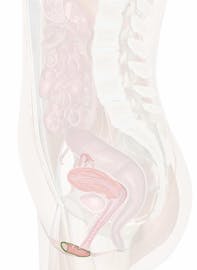The Labia Minora
Learn about the anatomy, function, and role of the labia minora with Innerbody's 3D illustration.

The labia minora are a pair of thin cutaneous folds that form part of the vulva, or external female genitalia. They function as protective structures that surround the clitoris, urinary orifice, and vaginal orifice.
The labia minora are found within the vulva inferior to the mons pubis and medial to the labia majora within the pudendal cleft. They extend from the floor of the pudendal cleft to the top of the labia majora or beyond, depending on the individual. In fact, the labia minora show a considerable amount of variation in length, width, shape, and pigmentation between individuals.
Unlike the surrounding mons pubis and labia majora, the labia minora are covered with hairless skin and contain very little adipose tissue. At their anterior end they meet at the clitoral hood, or prepuce, where they surround the lateral sides of the clitoris. From the clitoral hood, the labia minora extend inferiorly toward the anus, where they gradually decrease in size before merging with the skin of the perineum. The middle region of the labia minora covers and protects the urethral orifice and vaginal orifice from the exterior environment.
The labia minora are organs made of several distinct layers of tissue. The outermost layer is made of non-keratinized stratified squamous epithelium continuous with the surrounding skin. The lack of keratin makes the labia minora less tough and waterproof than the surrounding skin, but also makes them smoother and softer. Deep to the epithelium is a layer of fibrous connective tissue continuous with the dermis of the skin. Collagen and elastin protein fibers present in the connective tissues provide strength and elasticity to the labia minora, while vascular and nervous tissues support the cells of the outer epithelial layer. Blood flowing through many tiny capillaries in the connective tissue layer gives the labia minora their pinkish color. Many sebaceous glands are also present in the connective tissue and extend to the surface of the labia minora via ducts. Sebum, or oil, produced by the sebaceous glands coats the surface of the labia minora to lubricate and protect the underlying tissues.



